calsfoundation@cals.org
Frederick Steele (1819–1868)
Frederick Steele was a United States Volunteers major general and the commander of the Department of Arkansas in the Civil War. Union forces under his command took military control of the northern half of the state in September 1863. Faced with immense military and political problems as a result of the continuing war, however, Steele failed in his larger mission of politically and militarily stabilizing the state.
Frederick Steele was born on January 14, 1819, in Delhi, New York, the son of Nathaniel Steele III and his second wife, Dameras Johnson. Frederick Steele never married or had children. Little is known of Steele’s early years. He entered West Point in 1839. A friend and classmate of Ulysses S. Grant, he graduated in 1843 and was commissioned a second lieutenant. He served in the Mexican War from 1847 to 1848, then in California and Pennsylvania and at various posts in the West until the Civil War.
Appointed a major with the Eleventh Infantry on May 14, 1861, Steele commanded a brigade that saw action in Missouri at Dug Springs and the Battle of Wilson’s Creek. On September 23, he was appointed colonel of the Eighth Iowa Volunteers, and he received his appointment as brigadier general on January 29, 1862.
Steele assumed command of the First Division in Major General Samuel Ryan Curtis’s Army of the Southwest on May 9, 1862, and he participated in the subsequent invasion of Arkansas. Curtis’s objective was to occupy Little Rock (Pulaski County), but a lack of supplies and the growing Confederate guerrilla resistance forced him to abandon that objective and march to Helena (Phillips County), where he could be resupplied from the Mississippi River.
During the first half of 1863, Steele commanded an army corps that took part in the expedition to the Yazoo River, the assault on Chickasaw Bluffs, and the Battle of Arkansas Post. On May 17, he was promoted to major general and assumed control of a division that served in the Vicksburg Campaign. In July 1863, he was given command of Union forces in Arkansas with orders to clear the state of organized rebels.
Union forces under Steele took Little Rock on September 10. Until his reassignment on December 22, 1864, the only significant military action that Steele had been in command of was the Camden Expedition, part of the Red River Campaign. The objective in that campaign was to defeat Confederate general Edmund Kirby Smith and consolidate Union control of Arkansas and Louisiana. Hampered by supply problems and guerrilla activity, Steele retreated to Little Rock to avoid being surrounded by Confederates, fighting battles at Jenkins’ Ferry and Marks’ Mills, in which the Union army received heavy losses.
Union political and military authority had always been weak outside the garrison towns of Fort Smith (Sebastian County), Little Rock, and Helena; that authority was made even weaker after the Red River Campaign. This, coupled with the rejection of the credentials of the Arkansas congressional delegation in the summer of 1864, led President Abraham Lincoln to remove Steele from command.
Lincoln assigned Steele a political mission in Arkansas, which met with failure similar to that of the Red River Campaign. The mission involved working with Arkansas Unionists to recreate a loyal state government and to send to Washington a congressional delegation that the Republican Congress would accept. A conservative Democrat who opposed emancipation, Steele showed little enthusiasm for the task. His “conciliatory policy” toward former Confederates and Confederate sympathizers undermined the confidence Unionists had in Steele and undercut the Unionist movement in the state, preventing Steele from realizing Lincoln’s goal of restoring loyal government.
Steele went on to command forces in Alabama, Florida, and Louisiana during the rest of the war. From December 1865 to November 1867, he commanded the Department of the Columbia (Pacific Northwest). While on leave of absence in San Mateo, California, he died, apparently of a stroke, on January 12, 1868, and was buried in Colma, California.
For additional information:
Frederick Steele Papers. Special Collections. University of Arkansas Libraries, Fayetteville, Arkansas.
Frederick Steele Papers, 1845–1865. Special Collections and University Archives. Stanford University Libraries, Stanford, California.
Palmer, Patricia J. Frederick Steele: Forgotten General. Stanford, CA: Stanford University Libraries, 1971.
Ben Boulden
Times Record
This entry, originally published in Arkansas Biography: A Collection of Notable Lives, appears in the CALS Encyclopedia of Arkansas in an altered form. Arkansas Biography is available from the University of Arkansas Press.
 Civil War through Reconstruction, 1861 through 1874
Civil War through Reconstruction, 1861 through 1874 Military
Military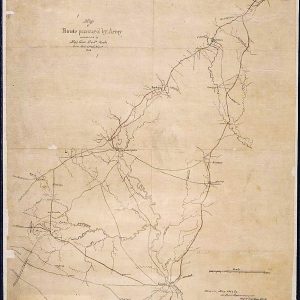 Camden Expedition Map
Camden Expedition Map 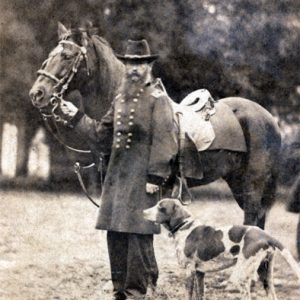 Frederick Steele
Frederick Steele  Steele Supply Depot
Steele Supply Depot 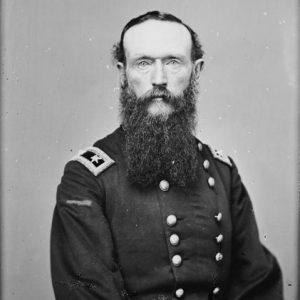 Frederick Steele
Frederick Steele 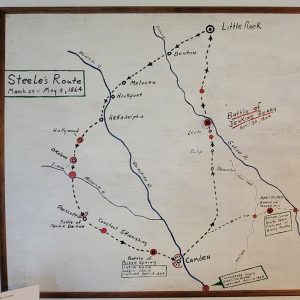 Steele's Routes
Steele's Routes 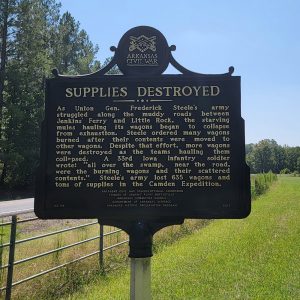 Supplies Destroyed
Supplies Destroyed 



Comments
No comments on this entry yet.